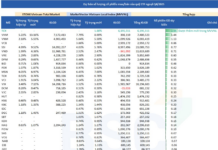After a stagnant first quarter, credit growth picked up in April and May and surged in June 2024, reaching the government’s target of a 5-6% credit growth rate for the first half of the year.
According to Deputy Governor of the State Bank of Vietnam, Dao Minh Tu, the credit growth targets for 2024 were communicated to all credit institutions by the end of December 2023, along with the publicly announced determination principles. This allowed commercial banks to proactively implement their credit growth strategies. As of June 28, 2024, credit to the economy increased by 6% compared to the end of 2023, focusing on economic growth drivers and new trends such as green credit and priority sectors.
Ha Thu Giang, Director of the Credit Department for Economic Industries, provided more details on the credit growth structure. She mentioned that the growth rates in the priority sectors were quite high: agriculture and rural areas grew by 2.17%, industry and construction by 4.3%, and supporting industries and high-tech industries saw remarkable growth rates of 9.8% and 18.16%, respectively, compared to the overall economic growth. Real estate credit, as of May 31, increased by 4.61% compared to the end of 2023, accounting for 21.51% of the total outstanding balance of the economy. Within this, real estate business credit increased by 10.29%, with a credit scale accounting for 39-40% of total real estate credit.

9% is the credit growth rate that the banking sector needs to achieve in the last six months to meet the 15% target for the year.
During the first six months, the State Bank also issued several policies, including extending the debt restructuring period and maintaining the debt group for another six months to support struggling businesses. Notably, the State Bank required commercial banks to publicly disclose lending rates and allowed borrowing from one bank to repay another. These moves have fostered a more competitive landscape among commercial banks to attract borrowers, especially in the second half of the year, which is expected to witness a surge in production and business activities.
To achieve the annual target of a 15% credit growth rate, the State Bank of Vietnam will maintain the operating interest rates to create favorable conditions for credit institutions to access capital from the State Bank at low costs, thereby supporting the economy. Additionally, the State Bank will instruct credit institutions to continue reducing costs to lower lending rates.
Deputy Governor Dao Minh Tu further shared that the State Bank will review and complete the legal framework to facilitate the supply of and access to bank credit. They will also promote specific credit programs and policies, address difficulties faced by businesses and people, and closely control credit in potential risk areas.
“The banking sector will maintain bank-business connections to address difficulties and unblock capital sources for business operations,” emphasized the Deputy Governor.
While acknowledging the implementation of multiple solutions to achieve the credit growth target, the State Bank’s leaders also recognized that credit growth depends on various factors, such as investment, consumption, and credit demand, as well as supportive policies for businesses and projects. They emphasized the need for other ministries and branches to address legal difficulties and create a conducive business environment, which would, in turn, increase the demand for credit.
“With the growth momentum in June and the current measures and action programs, we expect credit growth to remain positive until the end of the year, and we will strive to achieve the 15% target set at the beginning of the year,” said the Deputy Governor.

Agribank has aggressively implemented comprehensive solutions to promote safe credit growth.
Recognizing the unique strategies of credit institutions, Pham Duc An, Chairman of the Board of Members of Agribank, shared that Agribank has identified 2024 as a year of action and overcoming challenges. Despite the low capital absorption capacity of the economy, Agribank has aggressively implemented comprehensive solutions to promote safe and effective credit growth. Specifically, the bank launched 14 credit programs/products for new customers, including nine programs for individuals and five for businesses. They also increased the scale of the credit program for the forestry and fishery sectors from VND 3,000 billion to VND 8,000 billion. Notably, Agribank reduced lending rates four times, with the floor rate decreasing by 0.5-1% per year. Currently, Agribank’s VND lending rates are among the lowest in the market.
Several preferential credit programs have been effectively implemented by the bank. For instance, the credit program for the forestry and fishery sectors achieved a lending volume of VND 7,183 billion, serving over 5,000 customers. In the social housing credit program worth VND 120,000 billion, Agribank also led in disbursements. The bank approved 11 social housing projects with a total approved credit of VND 3,023 billion, a disbursement volume of VND 689 billion, and outstanding loans of VND 657 billion. They plan to disburse funds for five more projects soon, with a total approved credit of VND 1,558 billion. Additionally, they are in the process of approaching 12 other social housing projects, with a proposed credit volume of over VND 5,200 billion.
At VietinBank, Chairman Tran Minh Binh shared that the bank has vigorously implemented the government’s and State Bank’s directives on credit growth. As of June 30, 2024, VietinBank’s credit growth reached 6.7%, and by July 22, it stood at 7%. The bank also maintained tight control over credit quality, focusing on priority areas and government-led credit packages.
In the joint-stock commercial bank sector, HDBank’s Chairman, Kim Byoungho, shared that following the Governor’s Directive 01/CT-NHNN, HDBank promptly disseminated the directive to its business units and launched multiple preferential credit packages with lending rates as low as 5-6% per year. They streamlined the credit approval process and worked closely with customers to understand their needs and challenges, resulting in tailored products and solutions. As of June 30, HDBank’s credit balance exceeded VND 382,000 billion, reflecting a 13.3% increase compared to the beginning of the year, while bad debt was kept at a low level of 1.2%.
At the conference to review the banking sector’s performance in the first half and deploy tasks for the second half of 2024, held on July 24, Governor Nguyen Thi Hong emphasized that in the latter half of 2024, the State Bank of Vietnam would closely monitor market and economic developments domestically and internationally to make timely and effective monetary policy decisions. They will also coordinate harmoniously and closely with fiscal policy and other macroeconomic policies to support economic growth, stabilize the macroeconomy, curb inflation, and ensure stability in the monetary, foreign exchange, and banking markets.
Additionally, the State Bank will manage open market operations in line with market developments, support monetary stability, maintain appropriate interest rates considering the macro-balance, inflation, and monetary policy goals, and continue to instruct credit institutions to reduce costs to lower lending rates.
VPBank strengthens its system in 2023, laying the foundation for sustainable growth
By 2023, VPBank has made significant strides in expanding its customer base and scaling up its operations. The bank has managed to make progress amidst challenging macroeconomic conditions, focusing its resources on strengthening its system and building momentum for sustainable growth in 2024 and beyond.






































